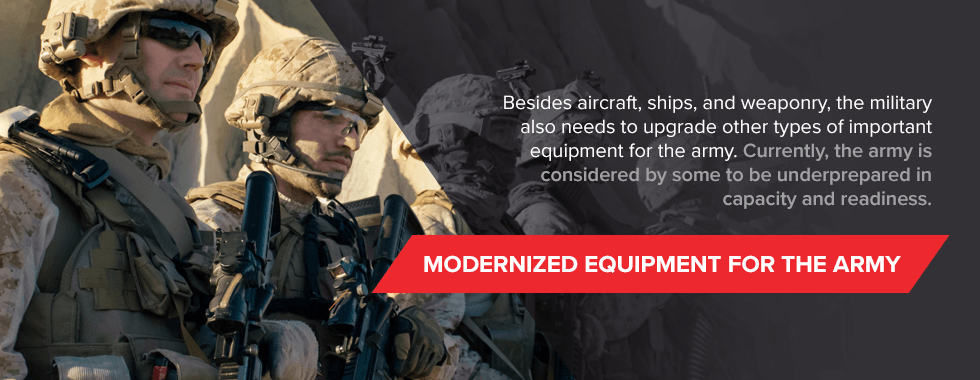
Quick Navigation:
- Recent Military Spending Trends
- A Much-Needed Boost in the Military Budget for 2019
- Aircraft and Other Related Systems
- Shipbuilding and Other Maritime Systems
- Missiles and Munition for Ships and Aircrafts
- Modernized Equipment for the Army
- Pay Increases for Military Personnel
- Updating Old Equipment and Making New Investments
The United States military is far and away the most powerful military force in the world. Of course, a world-class military requires an extensive amount of manpower and funding to function at peak performance. When it comes to enlisted military personnel, the U.S. Armed Forces are well over a million strong, not counting the many civilians working for the DoD. Our servicemen and servicewomen make it possible for our military to be the unmatched force that it is.
Funding is also a crucial determiner in how our military is able to perform. Though “providing for the common defense” has always been a priority for the U.S. Government, the national defense budget has fluctuated over the years based on different administrations and the state of world affairs. These fluctuations do affect the military as a whole, but they can also have a more pronounced effect on certain agencies within the DoD.
Whatever the defense budget, the question for military contractors and agencies becomes, what is the best way to spend these funds?
Recent Military Spending Trends
Since the turn of the millennium, military spending has steadily increased each year, until 2012, when the trend was reversed for the next three years, largely due to the Afghanistan War winding down. From 2015 to the present, we’ve again seen an annual uptick in the budget, partly due to the resurgence of ISIS.
Aside from the overall budget, different departments, agencies, and appropriation categories have experienced fluctuations and trends in how funding is allocated. As for the branches of the military, the army, navy, and air force have all taken turns receiving the largest percentage of the defense budget, even just over the course of the last decade.
One significant trend that transcends departments is that, since about 1980, the portion of the DoD’s base budget designated to operation and maintenance (O&M) has steadily increased and remains a large part of the budget. This increase in O&M funding is partly due to the need for increased spending in the categories of civilian compensation, health care for military families and fuel.
A Much-Needed Boost in the Military Budget for 2019
On August 13 of 2019, former President Trump signed a bill into law that substantially increased funding for the national defense. Per the National Defense Authorization Act, the military budget for 2019 is over $716 billion, which is $82 billion higher than the U.S. military budget for 2018. Addressing troops at Fort Drum in New York, former President Trump said, “After years of devastating cuts, we’re rebuilding our military like we never have before, ever, because we know that to survive and having that survival of our freedom, it depends on the might of our military.”

This expanded budget can equip the military to more effectively respond to international crises. A large sum of $69 billion has been specifically earmarked for overseas contingency operations in fighting the Islamic State group. A further $18.7 billion is going to the State Department and Homeland Security for the purpose of fighting ISIS. Across all operations, the emphasis with this budget is on, as former President Trump put it, “rebuilding” the military.
Rebuilding the military generally looks like upgrading a variety of materials, not to mention giving a pay raise to the troops. The next vital step after receiving this influx of funding is for contractors and agencies within the DoD to determine how exactly it should be spent. While the money could go to a variety of valuable applications, one area where the military needs to upgrade its outdated equipment is in its power supply systems.
No matter how modernized your equipment is, it is really only as good as its power source. Whether on land, at sea, or in the air, power supplies for the military need to be made to last and withstand the most rugged conditions. After all, a failed power supply could mean a failed mission. Let’s look at some of the ways 2019 defense funding will be allocated and where the military could benefit from upgrades.
Aircraft and Other Related Systems
In the past, the U.S. has spent a good portion of its military budget on aircraft — especially on the F-35 Joint Strike Fighter program. The 2019 budget will allow the military to expand and enhance its aircraft fleet and related systems. The budget can sustain approximately 287 new aircraft. It will also finance further research and development for Major Defense Acquisition Programs (MDAPs), such as those focused on the F-35 Joint Strike Fighter, the B-21 Bomber, and the RQ-4 Global Hawk.
As the U.S. military seeks to upgrade its aircraft systems for international warfare, it should also focus on upgrading to modern power supply systems to power these new and improved aircraft. When it comes to factors like input transient handling, maximum distortion, voltage limits, and more, MIL-STD-704 standards for power supply systems are demanding for a reason. For aircraft, power supply systems should be able to withstand some challenging conditions, including high altitude, shock and vibration, extreme temperature changes, and moisture.
The military needs to supply its world-class aircraft and related systems with world-class power supplies. You should look for power supply systems with advanced features like reverse overload polarity and remote on/off. Whether 270VDC, 3-phase, 115 VAC 400Hz, or 115 VAC 60 Hz, your power supply is necessary to run all sorts of electronics, displays and communication systems that are vital to modern aircraft. That’s why the power supply is not the place to cut corners or make compromises when upgrading aircraft and related systems.
Shipbuilding and Other Maritime Systems

Although not as significant as the budget for aircraft and related systems, a fairly large portion of funding is also slated to go to MDAPs related to shipbuilding and other maritime systems.
One such program is targeted at upgrading the CVN 78 Gerald R. Ford-class ships with new technologies that will improve the ships’ efficiency and reduce operating costs and crew requirements. Another program that will receive funding in 2019 is construction and continued development for the USS Enterprise (CVN 80). The DDG 51 Arleigh Burke-class guided-missile destroyers program will also receive funding that will go toward three Flight III DDG 51-class destroyers. This is part of a larger procurement that guarantees ten ships within the next four years.
Numerous other programs will also receive funding, including the Littoral Combat Ship (LCS),the Virginia-class submarine, and the replacement of the Fleet Ballistic Missile Submarine (SSBN) with the Columbia-class ballistic missile submarine. Across all programs, there will be efforts toward modernization and research and development of nuclear technologies and ship systems, such as combat systems technology, the propulsion system, and the common missile compartment.
The Navy has room to grow and increase its capability for international warfare. As the military invests in updating maritime systems, they should consider updating their power supplies as well. Shipboard equipment should be powered by a reliable source that can withstand the especially rugged conditions of maritime environments.
When you’re powering important components like satellite equipment, navigation systems, and more, you need a power supply that’s up to the task. Not only should power supplies be able to meet the specifications laid out in MIL-STD-1399, Section 300B, but they should also be able to offer features like active power factor correction, overcurrent protection, and tuned LC filters.
Missiles and Munition for Ships and Aircraft
Of course, all of the investments in better ships and planes won’t help if there isn’t also an investment in missiles and ammunition. The military plans to invest in procuring more preferred and advanced munitions. Due to recent engagements in counter-terrorism operations, many missile systems have quickly run their course and need to be replaced.
Likely, tens of thousands of munitions will be purchased for the purpose of replenishing stores used in operations against the Islamic State. One point of emphasis, in particular, is on Joint Direct Attack Munitions (JDAM). The military hopes to procure over 43,000 JDAMs to restore the many that were depleted by the air campaign against the Islamic State.
Across branches, one constant is that the military needs missiles and ammunition. It is vital that weaponized planes and ships rely on power supplies that will help instead of hurt their function. Weaponry impact can cause vibration and shock that power supply systems need to be able to resist. Equipping weaponized systems with the best power supply systems is an important step toward ensuring the efficiency and effectiveness of mission-critical weaponry.
Modernized Equipment for the Army

Besides aircraft, ships, and weaponry, the military also needs to upgrade other types of important equipment for the army. Currently, the army is considered by some to be underprepared in capacity and readiness. Budget cuts in the past have kept the army from being adequately staffed, and aging equipment has become a problem too. With the new budget, the army will be able to expand, and its equipment can be modernized. This should go a long way toward enhancing the army’s strength overall.
Modernizing equipment could include a variety of things. For one, the army should improve vehicles to more effectively withstand shock and hard terrain. They should also update computer systems to work better remotely and get the best battery life possible. Across applications, the emphasis is on modernizing technology to better meet the rugged demands of the army.
As with all other upgrading efforts, when it comes to vehicles, electronics, and other equipment, power supplies must be prioritized. The rest of the technology could be rendered useless without a reliable power supply system.
One significant issue with power supplies is counterfeiting. Using a power supply that contains counterfeit parts could have dire consequences if it causes the power supply to fail. An even worse consequence can occur if counterfeit parts are used to intercept data from other sources. Because of this, you should only purchase power supply systems from trusted sources who take all necessary measures to prevent counterfeiting.
Pay Increases for Military Personnel
Another way additional funding in the 2019 budget has been used is to give military personnel a well-deserved raise. Enlisted personnel and officers received a pay raise of 2.6 percent under the 2019 budget. This means total compensation for enlisted personnel was $61,700, and compensation for officers was $113,500.
In addition to accounting for inflation rates, this new development will contribute to a higher quality of life for servicewomen and men in the form of tax-free allowances for food and housing. Families back in the U.S. will benefit from these perks, and more money will be funneled back into the U.S. economy. This pay raise went into effect in January of 2019.
Updating Old Military Equipment and Making New Investments
As we have seen, the military has been hard at work determining the best way to distribute funds from the 2019 defense budget. Military families benefited from this budget, and the military was strengthened top to bottom. New aircraft and related systems, ships and maritime systems, missiles and ammunition, and other types of equipment can all benefit from upgrades that will give the U.S. Military an even greater advantage on land, at sea, and in the air. As decisions on how to spend funding continue to be made at all levels, upgrading power supply systems should undoubtedly be a priority.
Whatever the application, power supply systems are a crucial component of any piece of equipment. You should look for power supply systems that can meet the latest military standards and that offer additional features characteristic of cutting-edge technology. Only the best should be chosen to power mission-critical military systems.
To learn more, contact Advanced Conversion Technology (ACT) today. Our power supply systems are manufactured and inspected at our facility in the U.S. and are designed to meet and exceed military standards. Advanced features enable our power supplies to deliver uncompromising functionality in even the harshest conditions.
In addition to being reliable and rugged, our power supply systems are completely customizable. We understand that even with an expanded budget, the military must allocate its funds wisely. A high-quality power supply lays the foundation for other upgrades to work efficiently, so make this year the year you upgrade your power supplies before anything else.
